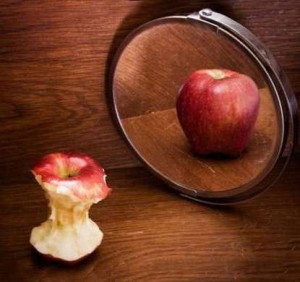Looking-Glass Self Definition
 The looking-glass self is the process by which people evaluate themselves based on how others see them. According to this theory, people first imagine how they appear to others. Second, they imagine how others judge them based on that appearance. Third, people have an emotional reaction to that imagined judgment, such as pride or embarrassment. This self-evaluation influences the person’s sense of self-worth or self-esteem. In short, the looking-glass self theory suggests that we come to know ourselves by reflecting on how others see us.
The looking-glass self is the process by which people evaluate themselves based on how others see them. According to this theory, people first imagine how they appear to others. Second, they imagine how others judge them based on that appearance. Third, people have an emotional reaction to that imagined judgment, such as pride or embarrassment. This self-evaluation influences the person’s sense of self-worth or self-esteem. In short, the looking-glass self theory suggests that we come to know ourselves by reflecting on how others see us.
Looking-Glass Self History and Modern Usage
The looking-glass self was first proposed by Charles Horton Cooley. According to Cooley, self-perceptions are based on reflected appraisals of how others see us (i.e., our impression of others’ impressions of us), which are in turn based on how others actually see us.
The looking-glass self theory is controversial for two reasons. First, this view supposes that people have a good idea of how significant others see them. Psychological research reveals that people’s beliefs about how others see them are not very accurate. Indeed, our reflected appraisals of how we think others see us are much more closely related to how we see ourselves than to how others see us. Some researchers have argued that this evidence implies that the looking-glass self theory is actually backward—it could be that people simply assume others see them the same way they see themselves.
The second reason why the looking-glass self theory is controversial is that other theories of self-perception provide alternative explanations for how people form their self-views. For example, self-perception theory claims that self-views are based on direct observations of one’s own behavior, rather than on how we imagine others see us. Nevertheless, our impressions of what others think of us are extremely important to us. People go to great lengths to obtain feedback about how others see them, such as posting their photographs on a Web site where others will rate their attractiveness. Some researchers have even proposed that the main purpose of self-esteem is to serve as an internal “sociometer”—a gauge of our relative popularity or worth among our peers.
Some evidence indicates that people’s reflected appraisals of how others see them influence their self-views and their behavior, particularly in close relationships. Research on romantic relationships suggests that our reflected appraisals of how our partners see us may be particularly important in this context. This is especially true for people who have doubts about how their partner feels about them. People with negative impressions of how their partner sees them tend to cause strain and dissatisfaction in their relationships.
References:
- O’Connor, B. P., & Dyce, J. (1993). Appraisals of musical ability in bar bands: Identifying the weak link in the looking-glass self chain. Basic and Applied Social Psychology, 14, 69-86.
- Shrauger, J. S., & Schoeneman, T. J. (1979). Symbolic interactionist view of the self-concept: Through the looking-glass darkly. Psychological Bulletin, 86, 549-573.